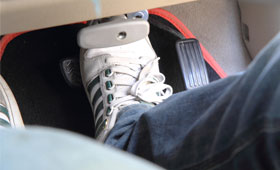Are you sitting comfortably?
Back ache affects four in five of us, so it’s a good bet that you have – or have had – a twinge or a niggling pain in the lower back or shoulders.
Of course, there are myriad reasons why we get back ache, but bad posture is a major cause.
It’s not just the position you maintain when sitting at your desk, your driving position can also contribute to those aches and pains – particularly if you drive frequently or for long distances.
But have you checked your seat and steering wheel positions to make sure they are right for you?
Many of us don’t but a study by Loughborough University found that the drivers whose cars have multiple seating and steering wheel adjustments – and use them – reported less discomfort than those drivers whose vehicles did not have them.
So, if you are prone to a sore back, take a look at Motors.co.uk’s top tips to put you back in the driver’s seat. A good driving position will also help to prevent accidents, too.
 1.Raise your seat until you have the best maximum road vision, but ensure that you have sufficient clearance of the roof and your legs aren’t touching the steering wheel.
1.Raise your seat until you have the best maximum road vision, but ensure that you have sufficient clearance of the roof and your legs aren’t touching the steering wheel.
2.Adjust the head rest so that it is level with the top of your head, and no lower than eye level.
3.Move the driver’s seat forwards until you can easily fully depress the clutch pedal and accelerator pedal. Make sure that your knees do not lock when you depress the pedals – they should be slightly bent.

4.Adjust the tilt angle of the seat cushion so that your thighs and bottom are fully supported.
5.The back rest should provide support all the way up your back to the shoulders. Make sure that you do not recline the seat too far because it will make your head and neck bend forward. Recline the seat to about 100-110 degrees angle for optimum comfort.
6.The lumbar support should provide even pressure. If you experience pressure points or gaps, adjust until these are eliminated. You may need to buy a lumbar support.
 7.Although it is important that you can see all the dials on your dashboard, the steering wheel should also be set in a position that offers maximum comfort with your hands at a ‘ten to two’ position. If you can adjust the steering wheel, do it so that your shoulders remain relaxed and your wrists are straight with a slight bend of your elbows. Never clutch the steering wheel and try not to sit too close to it, as this would mean the airbag is more likely to cause an injury should it be released.
7.Although it is important that you can see all the dials on your dashboard, the steering wheel should also be set in a position that offers maximum comfort with your hands at a ‘ten to two’ position. If you can adjust the steering wheel, do it so that your shoulders remain relaxed and your wrists are straight with a slight bend of your elbows. Never clutch the steering wheel and try not to sit too close to it, as this would mean the airbag is more likely to cause an injury should it be released.
8.Check the position of the rear-view mirrors – can you see comfortably without raising or twisting your head?

9.Take your wallet out of your back pocket and try to avoid holding the steering wheel with just one hand, as these can cause the pelvis to twist.
10.Finally, take regular breaks. Nothing beats getting out to stretch your legs, especially when on a long journey.
What do you do to ensure good posture while driving? Let us know in the comments below or via our Facebook page.


